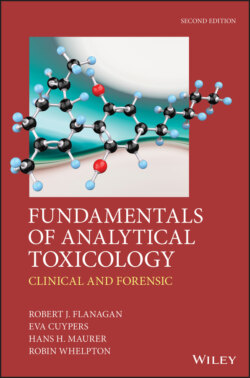Читать книгу Fundamentals of Analytical Toxicology - Robin Whelpton - Страница 11
Nomenclature, Symbols, and Conventions
ОглавлениеWe have followed IUPAC nomenclature for chemical names except when Chemical Abstracts nomenclature or trivial names are more readily understood. With regard to symbols, we have adopted the convention that variables and constants are italicized, but labels and mathematical operators are not. Thus, for example, the acid dissociation constant is written Ka, K being the variable, a being a label to denote that it is an acid dissociation constant. The notation for the negative logarithm of Ka is pKa – p is a mathematical symbol and is not italicized. Where the subscript is a variable then it is italicized, so the concentration at time t, is Ct, but the concentration at time 0 is C0. Note especially that relative molecular mass (molecular weight, relative molar mass), the ratio of the mass of an atom or molecule to the unified atomic mass unit (u), is referred to throughout as Mr. The unified atomic mass unit, sometimes referred to as the dalton (Da), is defined as one twelfth of the mass of one atom of 12C. The symbol amu for atomic mass unit can sometimes be found, particularly in older works. The unified atomic mass unit is not a Système International (SI) unit of mass, although it is (only by that name, and only with the symbol u) accepted for use with SI.
As to drugs and pesticides, we have used recommended International Non-proprietary Name (rINN) or proposed International Non-proprietary Name (pINN) whenever possible. For misused drugs, the most common chemical names or abbreviations have been used. It is worth noting that for rINNs and chemical nomenclature, it is now general policy to use ‘f’ for ‘ph’ (e.g. sulfate not sulphate), ‘t’ for ‘th’ (e.g. chlortalidone not chlorthalidone) and ‘i’ for ‘y' (mesilate not mesylate for methanesulfonate, for example). However, so many subtle changes have been introduced that it is difficult to ensure compliance with all such changes. Names that may be encountered include the British Approved Name (BAN), the British Pharmacopoeia (BP) name, the United States Adopted Name (USAN), the United States National Formulary (USNF) name, and the United States Pharmacopoeia (USP) name. Where the rINN is markedly different from common US usage, for example acetaminophen rather than paracetamol, meperidine instead of pethidine, the alternative is given in parentheses at first use and in the index.
Isotopically-labelled compounds are indicated using the usual convention of square brackets to denote the substituted atoms, and site of substitution where known. For example, [2H3-N-methyl]-hyoscine indicates that the hydrogen atoms in the N-methyl group have been substituted by deuterium – this should not be confused with N-methylhyoscine (methscopolamine).
A useful source of information on drug and poison nomenclature is the Merck Index Online (www.rsc.org/Merck-Index/). Chemical Abstracts Service (CAS) Registry Numbers (RN) provide a unique identifier for individual compounds, but it is important to note that salts, hydrates, racemates, etc., each have their own RNs. Similarly, when discussing dosages we have tried to be clear when referring to salts, and when to free acids, bases, or quaternary ammonium compounds.
The oxidation number of metal ions is given by, for example, iron(II), but older terminology such as ferrous and ferric iron for Fe2+ and Fe3+, respectively, will be encountered in the literature.
We emphasize that cross-referral to an appropriate local or national formulary is mandatory before any patient treatment is initiated or altered. Proprietary names must be approached with caution – the same name is sometimes used for different products in different countries.
